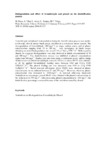Biodegradation and effect of formaldehyde and phenol on the denitrification process

Use este enlace para citar
http://hdl.handle.net/2183/13726Colecciones
- Investigación (FCIE) [1228]
Metadatos
Mostrar el registro completo del ítemTítulo
Biodegradation and effect of formaldehyde and phenol on the denitrification processFecha
2005Cita bibliográfica
Eiroa M, Vilar A, Amor L, Kennes C, Veiga MC. Biodegradation and effect of formaldehyde and phenol on the denitrification process. Water Res. 2005;39(2-3):449-55
Resumen
Formaldehyde and phenol biodegradation during the denitrification process was studied at lab-scale, first in anoxic batch assays and then in a continuous anoxic reactor. The biodegradation of formaldehyde (260 mg l−1) as single carbon source and at phenol concentrations ranging from 30 to 580 mg l−1 was investigated in batch assays, obtaining an initial biodegradation rate around 0.5 g CH2O g VSS−1 d−1. With regard to phenol, its complete biodegradation was only observed at initial concentrations of 30 and 180 mg l−1. The denitrification process was inhibited at phenol concentrations higher than 360 mg l−1. Studies were also done using a continuous anoxic upflow sludge blanket reactor in which formaldehyde removal efficiencies above 99.5% were obtained at all the applied formaldehyde loading rates, between 0.89 and 0.14 g COD (CH2O) l−1 d−1. The phenol loading rate was increased from 0.03 to 1.3 g COD (C6H6O) l−1 d−1. Phenol removal efficiencies above 90.6% were obtained at phenol concentrations in the influent between 27 and 755 mg l−1. However, when the phenol concentration was increased to 1010 mg l−1, its removal efficiency decreased. Denitrification percentages around 98.4% were obtained with phenol concentrations in the influent up to 755 mg l−1. After increasing phenol concentration to 1010 mg l−1, the denitrification percentage decreased because of the inhibition caused by phenol.
Palabras clave
Denitrifiction
Biodegradation
Formaldehyde
Phenol
Biodegradation
Formaldehyde
Phenol





